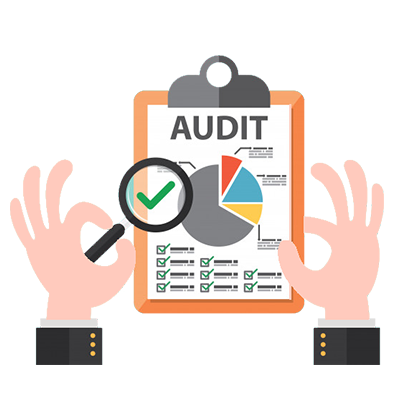
Financial Auditing
The trick is to stop thinking of it as “your money.
– IRS Auditor
For this unit, we will be discussing what an audit is, when and why you audit, as well as internal and external audits. I hope you’ve enjoyed learning this vital information and we’re sure you will find much use for it in the near future.
What is an Audit?
An audit is basically an examination of the accumulation of financial records, in order to determine if such records and, or financial statements are in accordance with the rules of Generally Accepted Accounting Principles or (GAAP). An audit can also help to determine if all records are free from any errors or material misstatements, or fraud. Any discrepancies may be reported to the Internal Revenue Service (IRS).

Interestingly enough, the practice of auditing is not only unique to present day government structures. Auditing was first introduced under the reign of Queen Elizabeth I in 1559, who established the Auditors of the Empress. They were responsible for auditing the exchequer payments. But even before then, there is said to have been a public official charged with auditing government expenditure as an Auditor of the Exchequer in 1314 England. Queen Elizabeth’s system, however did not sustain. Then finally in 1780, statute appointed the Commissioners for Auditing the Public Accounts

When and Why Would You Audit?
As stated above, an audit is usually done to make sure everybody is on the same page and appropriately and legally preparing their records in accordance with the proper rules and regulations of the (GAAP). Let’s not also forget about “BIG BROTHER” “UNCLE SAM” or whatever you choose to call that big government agency in the sky……… (No, not that one yet, let’s assume you’re still alive and kicking for the purposes of this training), but yes we are talking about the IRS. An audit, unlike accounting, is not concerned about the preparation of the proper documents, but is most concerned if they were prepared correctly and according to the guidelines of (GAAP) and free of fraud. There are six parts of every audit report, which include: the report title, the report address, the introductory paragraph, the scope paragraph, opinion paragraph, and the lastly the signature of CPA firm. Keep in mind the order may vary from auditor to auditor, but for the most part, the audit should contain all the elements listed above.
The best time to do an audit would probably be, when you are prepared to handle the stress of actually going through one. For the people who took this course, no worries, because you have all been taught to do everything the right way. For the rest, they might need to take a towel to collect all the sweat their going to accumulate during the audit. All joking aside, an audit is usually done before the release of the financial statements, but typically on an annual basis, before the end of each year.
Internal
There are two kinds of audits, internal and external. An internal audit is usually done by someone hired by a company or within the company, and doesn’t necessarily have to be a CPA (Certified Public Accountant). For the purposes of internal audits, some companies may have CIA’s, no not the Central Intelligence Agency, but a Certified Internal Auditor.

There is also a governing agency called (IIA), which is called the Institute of Internal Auditors. An internal audit is designed to add value and improve an organization’s operations, as well as improve the effectiveness of risk management, control, and governance processes. When there is room for improvement, an internal auditor may make suggestions, or recommendations for enhancing, processes, policies, and procedures.

External
An external audit is an audit that is done periodically by an independent entity, one outside of a company, to determine if accounts are accurate and complete, prepared in accordance with the regulations of the GAAP, and that the financial records have been done fairly, and appropriately.





